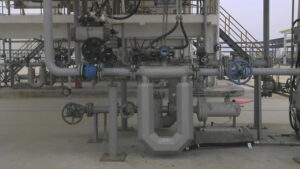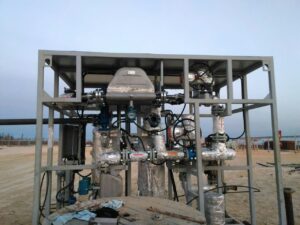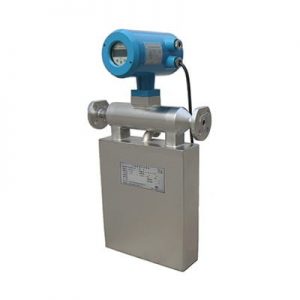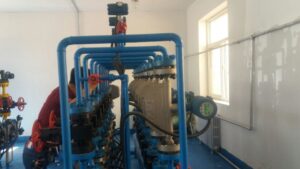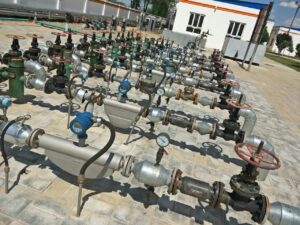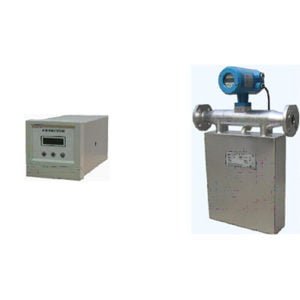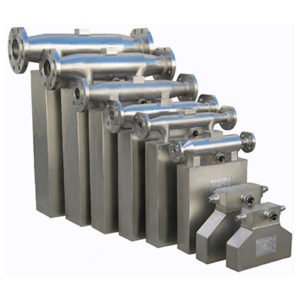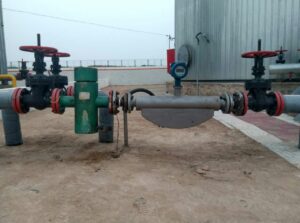If you want to measure the mass flow of the fluid, you need to use a mass flow meter. Due to the disadvantages of indirect mass flowmeters, such as many error factors, low accuracy grade, and complex structure, direct mass flowmeters should be considered when conditions permit. Coriolis, calorimetric, and impulse flow meters are the most widely used direct mass flow meters.
Generally, when detecting the mass flow of a solid material flow with relatively uniform powder particles, an impulse flow meter is used; when detecting the mass flow of a fixed component of medium and low-pressure gas, a calorimetric flowmeter is more used.
Detecting wave body and medium the mass flow of high-pressure gas is used, Coriolis mass flowmeters are usually used. This section will discuss the specific selection principles and selection methods of Coriolis mass flow meters.
Selection principle
1. Select the structure of the flowmeter according to the type of fluid being measured
The measuring tube of the Coriolis mass flowmeter has many forms, which need to be considered according to the type of medium to be measured.
In principle, the pure liquid with low viscosity has little requirement for the shape of the measuring tube; when measuring liquid with a small number of bubbles, the slurry containing solid particles, and high-viscosity liquid, the measuring tube should be selected which is not easy to accumulate bubbles or solid particles, and the inner wall is not easy to stick.
The shape of the attached medium; if used in the food industry, the measuring tube should be easy to clean.
2. Security Principles
When measuring corrosive fluids, attention should be paid to the corrosion resistance of the measuring tube, and the sensor housing should also be corrosive.
In case of the detection tube ruptures, safety protection measures should be taken before handling. Different media have different corrosiveness, and different materials have different anti-corrosion objects.
Pay attention to different treatments. When measuring wear-resistant media, the wear resistance of the measuring tube should be considered.
When the process pressure is high, pay attention to the pressure rating of the sensor to avoid damaging the measuring tube; when the medium is exposed to a high degree, consider the temperature range of the sensor to avoid damage to the detection element.
If the selected flowmeter is used in a hazardous area or harsh environment, special attention must be paid to the explosion-proof and protection level of the flowmeter to meet the requirements of safety standards.
3. Flow range Considerations
Two principles should be followed: First, the flow range of the flowmeter should cover the process flow range of the measured medium. Secondly, the commonly used process flow should fall within the economic flow range of the flowmeter. The so-called economic flow range has two meanings here:
One is because of the Coriolis mass flowmeter, it’s zero point stability has a greater impact on the accuracy of the lower limit flow measurement. The closer to the upper limit of flow, the smaller the influence of zero-point stability on accuracy. Therefore, the range of more than 1/3 of the upper limit of the flow meter can be called accuracy.
Economic flow rate range: Second, for the same type of flowmeter, if there are several measurable flow ranges that can cover the process flow range at the same time, the use of a smaller diameter flowmeter can obviously save money and be more economical.
But this economy is not absolute if one Weichailai sets the user flow within the range close to the upper limit of the flowmeter, which will inevitably cause the flow rate of the medium in the measuring tube to be too high, and the negative effect will be excessive pressure loss and increased insecurity. For some flammable and explosive media, if the flow rate is too high, it is easy to cause deflagration due to static electricity generated by friction. Therefore, care should be taken not to exceed the safe flow rate for such media.
4. Accuracy
The accuracy level requirements should be determined according to the measurement object and purpose. At the same time, attention should be paid to the calculation method of the product accuracy level and the use of conditions or restrictive factors to achieve this level. Generally speaking, Coriolis mass flowmeters use the percentage of the flow reading with zero-point stability to express the accuracy level. Some products use different flow sections corresponding to different error limits to express the accuracy level, and some products are used in the low flow section. The percentage of the full scale indicates the level of error.
For Coriolis mass flow meters, the following two points should be paid attention to when considering their accuracy grades: First, due to the particularity of the accuracy grade calculation method of this type of flowmeter, some products give very high accuracy. The degree level and the zero drift value are given at the same time It is also very high, thereby increasing its allowable error limit;
The second is that some products give high accuracy levels under low zero drift values, but the installation conditions it requires are almost harsh, and only Do it in the laboratory. Due to the ubiquity of on-site vibration and the limitation of the installation location, it is difficult to meet such installation conditions to achieve theoretical results. These two kinds of “high accuracy”. None of the levels are desirable. In the case of meeting the measurement accuracy requirements, the price must be considered Factors such as grid, do not blindly pursue an excessively high level of accuracy.
On the other hand, in principle, the measurement characteristics of the Coriolis mass flowmeter are not affected by the temperature and pressure of the medium. In fact, due to the limitations of the manufacturing process and material properties, the above factors still affect the characteristics of the flowmeter. Have a certain impact.
Flowmeter the factory verification conditions are generally fixed, and the use conditions are ever-changing. If the use conditions are too different from the verification conditions, the influence of these uncertain factors must be considered when selecting the model. At present, some products have been deduced and experimented with to obtain the measurement results of these factors.
The specific extent of the impact and the correction method. When selecting a flow meter for precision measurement, it is necessary to consider making corrections.
5. Pressure loss
In the field measurement, there are always certain requirements for the pressure loss of the flowmeter. When the density, viscosity, and flow rate of the medium are determined, the pressure loss of the flowmeter depends on its structure. For Coriolis mass flowmeters, it depends on the caliber, flow area, and measuring tube shape; when the structure of the sensor is determined, The greater the flow, the greater the pressure loss.
When calculating the pressure loss in the selection, the following points should be fully considered: the flow rate in the processing pipeline and the allowable pressure loss; whether the sensor meets the measurement accuracy requirements under the allowable pressure loss condition; the change in the viscosity and density of the process fluid The influence of pressure loss; in the application, avoid liquid vaporization due to excessive pressure loss. When other conditions are the same, a flowmeter with a smaller pressure loss should be selected.
6. Consideration of other performance factors
One is to consider the additional measurement performance of the bubble meter, such as the accuracy of the Coriolis mass flowmeter to measure the temperature and density of the medium; the other is to consider the volume and weight of the mass flow meter, as well as the limitations of special cables, etc. before installation factor.
7. Performance-price ratio
This is a basic principle of selection. In specific applications, in addition to considering good performance and low price, there is often a preference for the diversity of functions, and the more functions the better. In fact, as a mass flow meter, its main purpose is to detect fluid mass flow. Although the transmitter generally uses microelectronics computer technology and (ultra) large-scale integrated circuits, it can achieve more diversified functions, but this will inevitably increase the manufacturing cost, and some functions may not be necessary and practical in specific applications.
On the other hand, in theory, the more complex the performance and structure, the lower the reliability. Therefore, it is the correct principle to consider the performance-price ratio of the flowmeter from the actual needs. Consider the cost-performance ratio, which is usually what we call value for money. As a mass flow meter, this “value” is not only reflected in the number of functions and performance, but also in product sales and services.
With the advancement of technology and our own continuous efforts, the gap in manufacturing level among manufacturers is shrinking day by day. Outstanding ones have become complementary to each other. According to the above selection principles, sometimes a measuring point can first select several brands of available products. In this case, the flowmeter of a strong manufacturer should be selected.
To examine the strength of a manufacturer, we must not only look at its manufacturing level, and production capacity, but also its service level. This service not only represents the usual after-sales service but also includes pre-sale and in-sale services.
In addition to introducing product performance, proposing quotations, promising services, and other common practices, this will pre-train users to master the installation and debugging and handling methods of some common faults, until they guide the installation and help to debug.
The length of the delivery cycle, the specific measures to ensure product quality, the response speed and processing level when the free service time fails, the guarantee of spare parts, and even the service attitude of maintenance personnel, etc., all represent the service level of the manufacturer. The above selection principles sometimes restrict each other.
In actual selection and work, everything must be based on the actual needs of the site and comprehensively considered. It can also be emphasized according to the different characteristics of different occasions. Only by doing a good job in selecting the strong, can the instrument be used well, it can be said that the correct selection is the prerequisite for satisfactory use.


